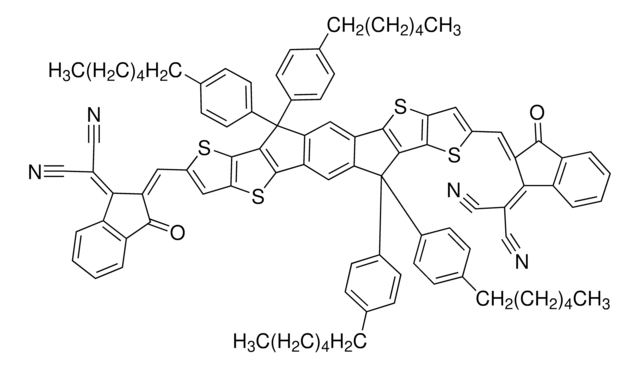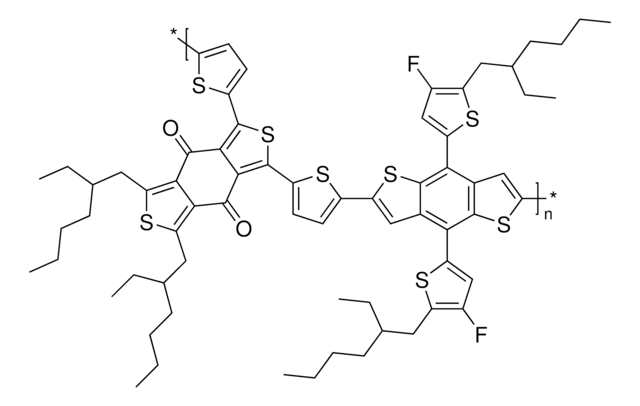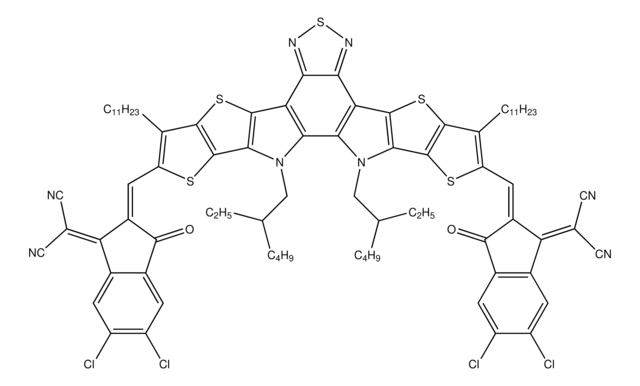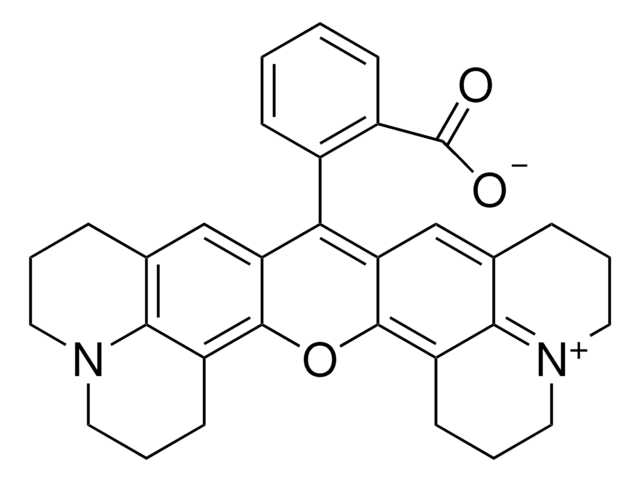Wichtige Dokumente
912751
Y5
≥99%
Synonym(e):
(2,2’-((2Z,2’Z)-((12,13-bis(2-ethylhexyl)-3,9-diundecyl-12,13-dihydro[1,2,5]thiadiazolo[3,4e]thieno[2’’,3’’:4’,5’] thieno[2’,3’:4,5]pyrrolo[3,2-g] thieno[2’,3’:4,5]thieno[3,2-b]indole-2,10-diyl)bis(methanylylidene))bis(3-oxo-2,3-dihydro1H-indene-2,1-diylidene))dimalononitrile)
About This Item
Empfohlene Produkte
Beschreibung
Band gap: Eg=1.38 eV
Qualitätsniveau
Assay
≥99%
Form
solid
Farbe
dark
Energie der Orbitale
HOMO -5.55 eV
LUMO -3.87 eV
SMILES String
[s]1nc2c(n1)c3c4[s]c5c([s]c(c5CCCCCCCCCCC)\C=C%11/C(=O)c%12c(cccc%12)C/%11=C(C#N)C#N)c4[n](c3c6[n](c7c([s]c8c7[s]c(c8CCCCCCCCCCC)\C=C9\C(=O)c%10c(cccc%10)C\9=C(C#N)C#N)c62)CC(CCCC)CC)CC(CCCC)CC
InChIKey
AQGSDAUCGRTLKJ-AXQTZOLBSA-N
Allgemeine Beschreibung
Anwendung
Lagerklassenschlüssel
11 - Combustible Solids
WGK
WGK 3
Flammpunkt (°F)
Not applicable
Flammpunkt (°C)
Not applicable
Hier finden Sie alle aktuellen Versionen:
Analysenzertifikate (COA)
It looks like we've run into a problem, but you can still download Certificates of Analysis from our Dokumente section.
Wenn Sie Hilfe benötigen, wenden Sie sich bitte an Kundensupport
Besitzen Sie dieses Produkt bereits?
In der Dokumentenbibliothek finden Sie die Dokumentation zu den Produkten, die Sie kürzlich erworben haben.
Artikel
The emerging organic photovoltaic (OPV) technology is very promising for low-cost solar energy production. OPV devices can be produced using high-throughput, large-volume printing methods on lightweight and flexible plastic substrates, making them easy to deploy and use in innovative ways.
Unser Team von Wissenschaftlern verfügt über Erfahrung in allen Forschungsbereichen einschließlich Life Science, Materialwissenschaften, chemischer Synthese, Chromatographie, Analytik und vielen mehr..
Setzen Sie sich mit dem technischen Dienst in Verbindung.





![2,5-Dihydro-3,6-di-2-thienyl-pyrrolo[3,4-c]pyrrole-1,4-dione 97%](/deepweb/assets/sigmaaldrich/product/structures/209/681/63a4048f-a2a7-496b-814d-ccb4b5b76124/640/63a4048f-a2a7-496b-814d-ccb4b5b76124.png)

